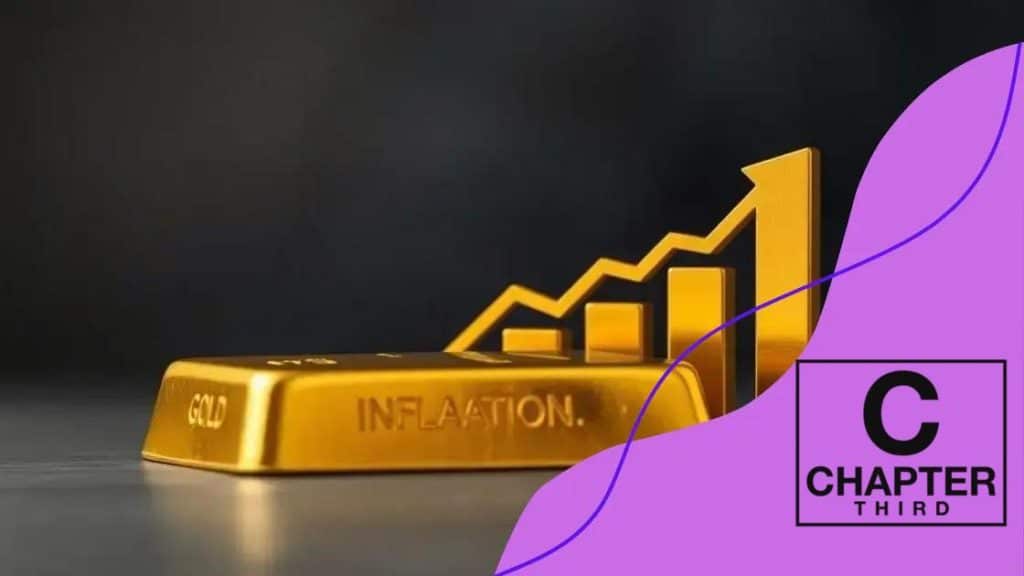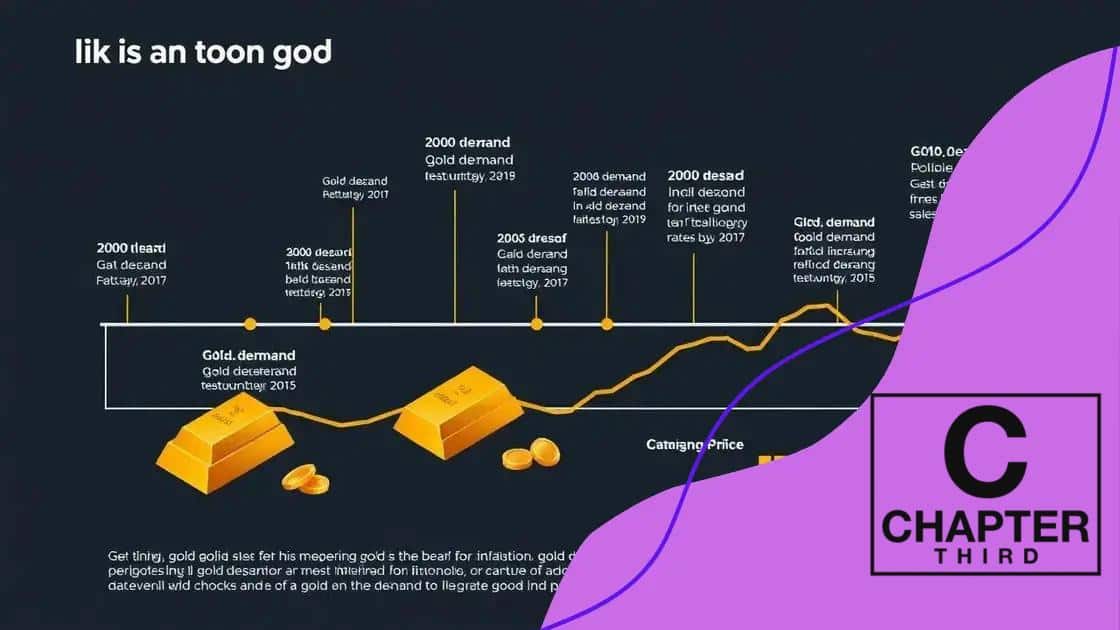Inflation drives demand for gold: what you need to know

Inflation drives demand for gold as investors seek it as a safe haven, leading to increased prices and influencing investment strategies in uncertain economic conditions.
Inflation drives demand for gold as investors seek safe havens amidst economic uncertainty. Have you ever wondered why gold remains a powerful investment during turbulent times? Let’s delve into the reasons behind its enduring appeal.
Understanding the relationship between inflation and gold
Understanding the connection between inflation and gold is essential for investors seeking stability. As inflation rises, many turn to gold as a reliable store of value, especially during uncertain economic times. This precious metal has stood the test of time as a hedge against rising prices.
Why Gold Matters During Inflation
Gold often reflects the economic sentiment. Investors flock to this commodity when they fear devaluation of currency due to inflation. Historical data supports this trend, showing that during periods of high inflation, gold prices typically increase.
- Gold serves as a safe haven asset.
- It maintains its purchasing power over time.
- Investors view it as a hedge against currency risk.
Additionally, the demand for gold tends to spike during major economic events. These events can range from geopolitical instability to financial crises. For instance, the financial downturn in 2008 led to a surge in gold prices as people sought financial security.
Historical Trends
Looking back at historical trends, when inflation rates accelerated, gold prices have often followed suit. This correlation is not merely coincidental; it shows how inflation diminishes the value of currency, while gold remains robust. In many cases, individuals and institutions increase their gold holdings, causing prices to rise further.
This sustained interest in gold underscores its enduring value in both personal and institutional portfolios. Gold is not just a precious metal; it’s a resilient investment choice.
Factors influencing gold prices during inflation
Several factors influence gold prices during inflationary periods. Understanding these elements can help investors make informed decisions. When inflation rises, the purchasing power of currency decreases, prompting individuals to turn to gold as a safe investment.
Market Sentiment
Market sentiment plays a crucial role in determining gold prices. During inflation, fear and uncertainty often drive people to invest in gold, increasing demand. This heightened demand typically results in higher prices as investors seek to protect their wealth.
- Increased demand from retail investors.
- Institutional buying boosts market confidence.
- Speculation can drive prices higher.
Moreover, economic stability or instability significantly impacts investor behavior towards gold. During times of uncertainty, gold often benefits from its status as a safe haven.
Supply and Demand Dynamics
The balance between supply and demand is another critical aspect influencing gold prices. While demand increases during inflation, the supply of gold is relatively fixed. This causes a potential spike in prices as demand outstrips supply. Gold mining is a long and costly process, and any disruptions in production can further affect availability.
Additionally, geopolitical issues can disrupt supply chains, impacting prices as well. Conflicts and trade restrictions may limit gold production, which can lead to further price increases.
Finally, inflation rates themselves have a direct correlation with gold prices. As inflation rates climb, gold becomes more attractive as a hedge, leading to increased purchasing activity from various sectors. This creates a cycle where rising prices also attract new investors looking to benefit.
Historical trends of gold demand in inflationary periods

Historical trends show that gold demand tends to rise significantly during inflationary periods. Understanding these trends can offer valuable insights for investors. Whenever inflation spikes, the purchasing power of cash decreases, making gold an attractive option for wealth preservation.
Gold’s Role in Past Inflation
Looking back, we can see how gold has served as a reliable store of value. For instance, during the 1970s, high inflation rates led to a dramatic increase in gold prices. Investors turned to gold to protect their assets, driving up its demand. This response to inflation is consistent and observable across various economic scenarios.
- Gold prices surged over 500% during the 1970s inflation.
- Similar demand spikes were observed during the 2008 financial crisis.
- Investors use gold as a hedge against economic uncertainty.
As inflation rates climb, consumer behavior shifts towards securing gold as a financial anchor. During these times, the global demand for gold often outpaces supply, pushing prices even higher.
Recent Trends
In recent years, a noticeable pattern has emerged. For example, in the wake of the COVID-19 pandemic, inflation fears sparked increased gold purchases, with many turning to this precious metal as a safeguard for their investments. This trend illustrates how consumers react similarly to inflation fears across different contexts, further solidifying gold’s status as a go-to asset during financial instability.
Various factors also contribute to these historical trends, including geopolitical tensions, changes in monetary policy, and the overall economic climate. Each of these elements plays a role in influencing how investors approach gold during uncertain times. Thus, tracking these trends is essential for understanding how gold can fit into modern investment strategies amidst inflation.
Investment strategies for acquiring gold
Investing in gold can provide a safe harbor during economic uncertainty. Understanding effective investment strategies is key to successfully acquiring gold. Whether you are a seasoned investor or just starting, knowing your options can help you make sound decisions.
Different Ways to Invest in Gold
There are several methods to gain exposure to gold. Investors typically consider physical gold, gold ETFs, and mining stocks. Each of these options has its advantages and risks. Physical gold involves purchasing gold bars or coins, which can provide an immediate sense of security.
- Gold bars offer a straightforward investment with low premiums.
- Gold coins can also be collectible, adding potential value.
- Gold ETFs track the price of gold and are easier to trade.
Mining stocks offer another angle by investing in companies that produce gold. Investing in these stocks means you may benefit from the companies’ operational success along with gold price increases.
Long-term vs Short-term Strategies
When considering gold investments, you should determine your time frame. Long-term investors may prefer physical gold, as it historically maintains value over decades. In contrast, short-term traders might focus on gold ETFs to capitalize on price fluctuations.
It’s also important to set clear financial goals. Decide whether you want to hedge against inflation, diversify your portfolio, or profit from short-term trading. Regularly reassessing your investment strategy ensures it aligns with your current market conditions and personal goals.
Ultimately, successful gold investment requires staying informed about market trends, economic indicators, and global events that impact gold prices. Whichever strategy you choose, understanding the nuances of gold investing can boost your confidence and help secure your financial future.
Future outlook: Gold’s role in an inflationary economy
The future outlook for gold in an inflationary economy appears promising. As central banks continue to print money and inflation rates rise, the demand for gold is likely to increase. Investors often see gold as a hedge against inflation, making it a sought-after asset during uncertain economic times.
Continued Demand
In the coming years, many analysts predict that the demand for gold will remain strong. As inflation erodes purchasing power, more investors will turn to gold to safeguard their wealth. This trend has historical significance, as gold has consistently solidified its role as a safe haven during economic distress.
- Increased gold purchases from central banks are expected.
- Factors like geopolitical tensions can drive demand higher.
- Retail investors may also seek gold as a means of security.
Market conditions such as rising interest rates, currency fluctuations, and political instability will further influence gold prices and demand. For instance, if inflation persists, we may see a corresponding rise in interest from both domestic and international markets.
Investment Strategies Moving Forward
Investors should consider how changing economic dynamics could affect their strategies for acquiring gold. Many may prioritize physical gold, ETFs, or mining stocks to maintain a diversified portfolio. Keeping up with market trends will help investors make informed decisions despite potential uncertainties.
Experts recommend that investors stay alert to signs of inflation and economic shifts. Those who act swiftly can capitalize on rising gold prices, ensuring their investments are well-positioned for future challenges. The demand for gold is likely to rise, as more people and institutions recognize its significance as a reliable investment during inflationary times.
In conclusion, gold continues to play a vital role in an inflationary economy. Its value as a safe haven becomes even more pronounced during challenging financial times. Investors looking to hedge against inflation should consider gold in their portfolios. Understanding market trends and adapting investment strategies can enhance the chances of benefiting from this precious metal. As inflation persists, the demand for gold is expected to rise, making it a critical asset for those seeking financial security.
FAQ – Frequently Asked Questions about Gold and Inflation
Why is gold considered a safe haven during inflation?
Gold is viewed as a safe haven because it tends to retain value when inflation reduces the purchasing power of currency.
How does inflation impact gold prices?
When inflation rises, demand for gold typically increases, leading to higher prices as investors seek protection for their assets.
What are some effective strategies for investing in gold?
Investors can consider options like purchasing physical gold, investing in gold ETFs, or buying shares in mining companies to diversify their portfolios.
How can I monitor economic trends that affect gold prices?
Keeping an eye on inflation rates, central bank policies, and geopolitical events can help you understand market trends and make informed investment decisions.





